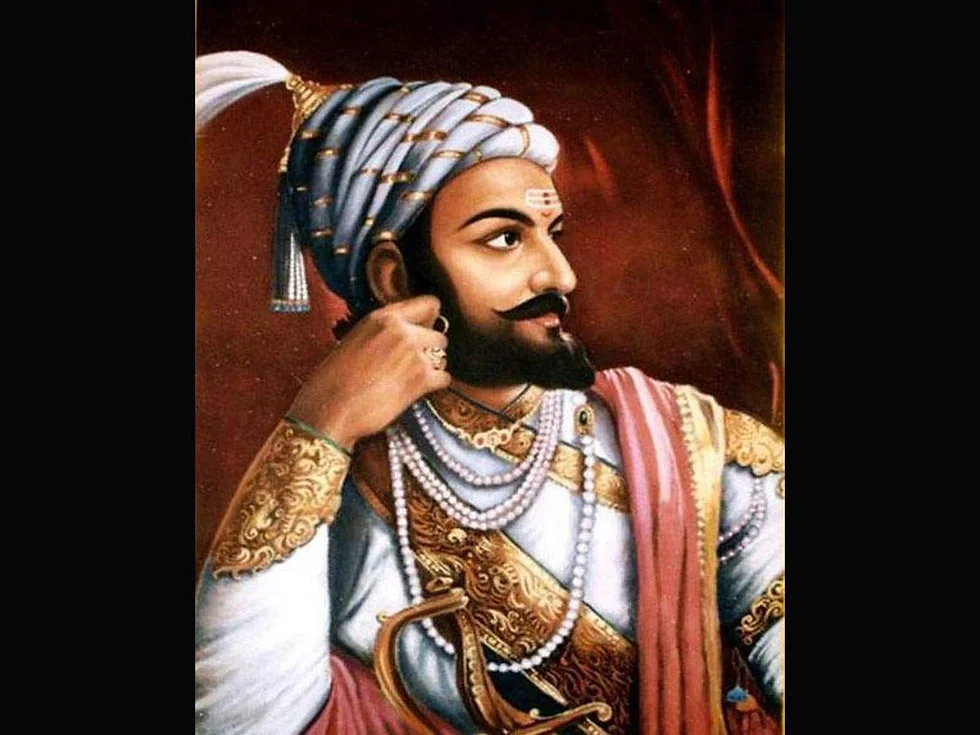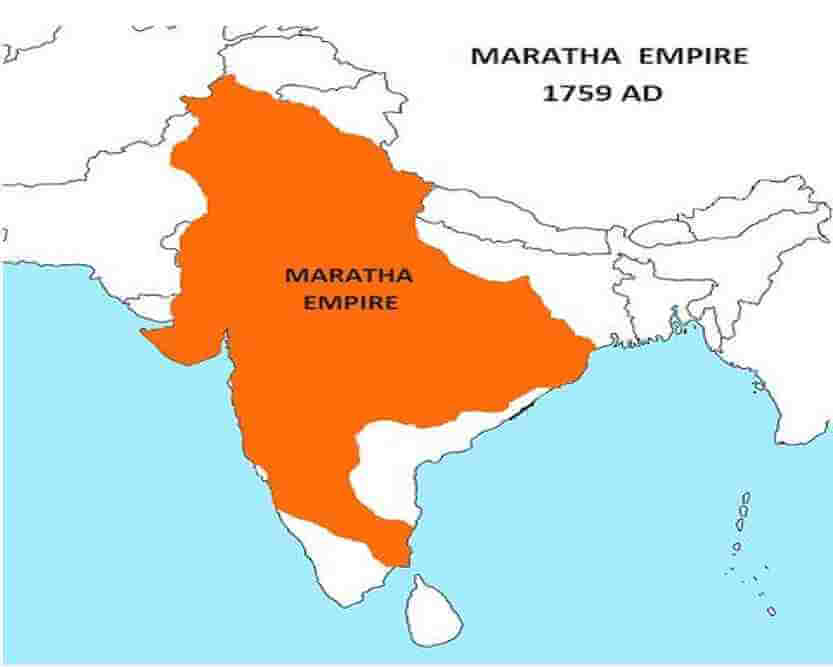- Home
- Indian Dynasties
- Maratha Empire
Maratha Empire
Maratha Empire
Important Facts:
Country: India
Empire: Maratha Empire
Founder: Shivaji Bhonsle
Period of Rule: 1674 – 1818
Capitals: Raigad Fort, Gingee, Satara, Pune
Languages: Marathi and Sanskrit
Preceded by: Mughal Empire, Bijapur Sultanate.
Succeeded by: British East India Company, Sikh Empire
Rulers: Chhatrapati: Shivaji ( 1674-1680), Pratap Singh ( 1808-1818)
Peshwa: Moropant Pingle ( 1674-1683), Baji Rao ( 1803-1818), Nana Saheb
Update on coronavirus in India
Introduction:
The Maratha Empire was a powerful Hindu empire that existed in India from the late 17th century to the mid-19th century. It was founded by Shivaji Maharaj in 1674, who was a Maratha warrior and chieftain. The Empire which is also known as Maratha Confederacy began to rule with the coronation of Shivaji of Bhonsle dynasty in 1674. Under Shivaji's leadership, the Maratha Empire grew rapidly, conquering many territories and expanding its influence over large parts of India. After his death, the empire was further expanded under the leadership of his successors, including the Peshwas. The Marathas were a Marathi speaking warrior from the western Deccan Plateau. They rose to importance by establishing Hindavi Swarajya (self-rule of Hindus).
The Maratha Empire reached its peak in the 18th century, when it controlled most of the Indian subcontinent. It was known for its military strength, warfare tactics and administrative reforms. The Marathas were also known for their patronage of art, literature, and architecture.
However, the Maratha Empire started to decline in the late 18th century due to internal conflicts and external pressures from other powers, such as the British. The empire was finally defeated by the British in the Third Anglo-Maratha War in 1818, which led to the end of Maratha dominance in India.
History of Maratha Empire
The Maratha Empire is also known as the Maratha Confederacy. The history of the Maratha Empire can be divided into three distinct periods. The rise of the empire under Shivaji, the expansion of the empire under the Peshwas and the decline of the empire leading to its eventual downfall. After the guerrilla warfare with the Adilshah of Bijapur and Mughal Emperor Aurangzeb, Shivaji founded the Maratha Empire in 1674. He established himself as a strong leader of the Maratha Empire. He built a strong army and fought against the Mughal Empire which was the dominant power in India at that time.
Shivaji had extensively campaigned across India and had gained vast areas of land and wealth. Shivaji had also gained a lot of popularity and respect. The preparation for coronation had started as early as in 1673. Due to some sort of controversy the coronation ceremony got delayed. Finally, Shivaji was crowned as king of Maratha Empire in a lavish ceremony on 6th June 1674 at Raigad Fort. Close to 50,000 guests were invited for the coronation ceremony. Also, the title “Chhatrapati” was bestowed on him during the coronation.

The main focus of Shivaji was to expand his kingdom. At the time of his death, he strengthened his empire with 300 forts, 50,000 soldiers and 40,000 cavaliers. After the death of Shivaji in 1680, his son Sambhaji took over the rule and further expanded the empire. He never gave up to the threat of the Mughals and fought bravely till 1689. Sambhaji was captured by the Mughal troops in 1689. He was captured and executed by the Mughals on various charges including attacks by the Maratha forces on Burhanpur.
Rajaram who was the half brother of Sambhaji took over the power after the death of Sambhaji. Mughals captured the Raigad and hence Rajaram had no other option but to flee to Vishalgad to Gingee for his safety. The Marathas recaptured some of the forts from the Mughals. Rajaram died in 1700. After the death of Aurangzeb in 1707, the Maratha Empire had many rulers like Rajaram’s widow, Shahu ( Sambhaji’s son). Under Shahu’s rule, Balaji Vishwanath was appointed as Peshwa in 1713. Shahu was more dependent on Peshwa Balaji Vishwanath.
Peshwa Era:
Peshwas belonged to Bhat family and became the rulers of Maratha Empire. In 1714, Balaji Vishwanath entered into an agreement with the Kahnoji Angre with the “Treaty of Lonavala”. Kahnoji were the most powerful rulers of the west coast. The Marathas became very strong and in 1719 they moved towards Delhi. They made the Mughals puppets in their hands by defeating Sayyid Hussain Ali. Balaji Vishwanath died in 1720 after Baji Rao I was made the Peshwa by Shahu. Baji Rao, I ruled from 1720 to 1740 and fought around 41 battles.
After the death of Baji Rao, I his son Balaji Baji Rao I was appointed as next Peshwa by Shahu. The Maratha Empire reached its peak during the Balaji Baji Rao period. In 1740 under the guidance of Raghoji Bhonsle defeated the Nawab of Arcot and controlled the Nagpur Kingdom of the empire. Raghoji later moved south and did a successful campaign in Karnataka and Trichinopoly. Later he initiated six expeditions into Bengal and annexed Odisha. Under the leadership of Raghunath Rao who was the brother of Balaji Bajirao captured Delhi in 1957 by defeating the Afghans troops in the Battle of Delhi. Further the Marathas captured Peshawar in the Battle of Peshawar. By 1760 Marathas had reached its peak.
The superpower of Marathas caused great concern to many kingdoms. Ahmad Shah Durrani of Durrani Empire took the help of Nawab of Oudh and the Rohillas to fight against Marathas. The battle between Marathas and Muslim in the Third Battle of Panipat took place in 1761. Before the battle of Panipat, the Marathas had asked Jats and Rajputs to support them in the battle. But both Jats and Rajputs refused to support them in the battle. This led to the defeat of the Maratha army in the battle. The Marathas were criticized for not treating the fellow Hindus with respect during their power. The Marathas had angered the Jats and Rajputs by taxing them severely after defeating Mughals.
After the loss at Panipat, Madhavrao I worked hard to rebuild the Marathas in the important territories. To manage effectively he divided the autonomy to many chieftains. Some of the prominent and important were the Gaekwars of Baroda, the Sindhias of Gwalior, the Holkars of Indore, the Bhonsales of Nagpur. All these became independent kingdoms after the fall of Maratha Empire. In 1775, the British East India Company intervened in the succession of the Peshwa family.
This led to the first Anglo Maratha War. The first Anglo Maratha war was fought between 1775-1782 which ended in the Maratha victory. However, the second and the third Anglo Maratha war led to the victory of the East India Company. The second and third were fought between 1803-1818. The East India Company was able to take control of most of the Indian subcontinent. The Maratha rule came to an end in 1818 with the defeat of Peshwa Baji Rao in the third Anglo Maratha War.
Resurrection of Maratha Power
Maratha resurrection is the period between the Third Battle of Panipat in 1761 and Najibabad in 1772. The Maratha Empire had to face a huge loss in the Third Battle of Panipat from the Muslim alliance of Durrani Empire and Mughal Empire. Their power was almost taken out from North India.
Madhav Rao, I became the Peshwa after the death of Balaji Baji Rao Bhat. Under his rule the Maratha Empire began to resurrect its power both in Delhi and Deccan under the authority of Raghunathrao Bhat. He sent various generals like Holkars, Scindias, Bhonsle to the Northern part of India to gain back the respect and power. In 1767 Madhav Rao I crossed the Krishna River and defeated Hyder Ali in the battle of Sira and Madgiri.
In 1771, Mahadi Shinde defeated Rohillas and Jats and recaptured Delhi and Haryana to Marathas. After taking control over Delhi the next destination of Marathas was Rohillas. They devastated the Rohilkhand by looting and taking the royal members to captives. Madhav Rao died in 1772 at a very young age. His death was a huge blow to the Maratha Empire.
Administration of Maratha Empire
The Maratha Empire had a well-organized administrative system that was able to manage and control the vast territories that it controlled. The Marathas also implemented a system of military governance, known as the Ashtapradhan system. It was formed during the period of Shivaji. The eight important ministers were Peshwa (Prime Minister), Amatya (Finance Minister), Sachiv (secretary), Mantri (Interior Minister), Senapati (Commander-in-chief), Sumant (Foreign Minister), Nyayadhyaksh (chief justice), Panditrao (High Priest) and Chitnis (Personal Secretary). Each minister was assigned with an administrative department.
The Maratha Empire had a very good administrative system. During the period of Shivaji, he abolished the Jagirdari system and introduced the Ryotwari system. He also imposed heavy taxes on non Maratha territories and also threatened the non maratha rulers if they didn't pay the taxes that were imposed on them. Also three ministers that is Peshwas, Shiva and Mantri were given in charge of provinces. Other than the ministers like Panditrao and the Nyayadhish, the other pradhans held military commands and had to serve in a war whenever it was required.

Shivaji built a very disciplined and strong army. He also developed a very strong Navy. The Marathas undertook several sea raids and destroyed European trading vessels and Mughal Naval Ships.
The Marathas were also known for their tolerance of other religions and cultures. They respected the religious beliefs of their subjects and allowed them to practice their own faiths. The Marathas also supported the arts, literature, and architecture, and many notable works of Marathi literature were produced during this time.
Military
The Maratha Empire had a well-organized military system that played a significant role in the empire's expansion and success. For better administration, Shivaji abolished the land grants or jagirs to military officers and formed a salary system and cash payment for their services. The Maratha military was composed of a mix of infantry, cavalry, and artillery, and was known for its mobility and flexibility. The Maratha Empire consisted of soldiers from all religions and from different backgrounds which included Sikhs, Arabs, Rajputs, Pathans and others. The army consisted of a regular cadre of officers above him; there was one supreme commander.
The military was divided into two components namely horses and the foot which were known as cavalry and infantry. The cavalry was the most important military of the Empire. The cavalry was renowned for its skill and mobility and was able to cover long distances quickly. The infantry was composed of light and heavy troops which was mainly used for assault and defense. The Maratha Infantry were trained in the use of swords, spears, muskets and were known for their discipline and courage.
The system of infantry of the Maratha Army was praised by many enemies including the Duke of Wellington. Due to the presence of the rugged mountain terrain, Shivaji gave more importance to infantry as against cavalry. The army system during Shivaji was very well organized and disciplined.
The Maratha artillery was also an important part of the military system. The Marathas had a large number of cannons and mortars, which were used for siege warfare and field battles. The Maratha artillery was manned by trained gunners, who were skilled in the use of the weapons. Shivaji hired foreign mercenaries for assistance to manufacture weapons.
The Maratha military was organized into a hierarchy, with the top commanders being the Peshwa, who was the chief minister of the empire, and the Senapati or commander-in-chief, who was responsible for the overall command of the army. The Maratha army was also divided into several units, each of which was led by a commander, known as a subedar. Cavalry was divided into two high rankings known as Sheildar and Bagir. The Infantry had Hetkari musketeers and Mavales.
The Marathas had a system of military governance, known as the Ashtapradhan system, which was composed of eight ministers who were responsible for various aspects of military administration, such as logistics, intelligence, and recruitment.
It can be said that the Maratha military system was well-organized and efficient, and played a significant role in the empire's success. The Maratha military was known for its mobility, flexibility, and discipline, and was able to adapt to a wide range of battle conditions.
Rulers of Maratha Empire
- Shivaji Bhosale (1630-1680): He established the Maratha state in western India and fought against the Mughal Empire to expand his territory.
- Sambhaji Bhosale (1657-1689): Sambhaji was the son of Shivaji and succeeded him as the second Chhatrapati of the Maratha Empire. He continued his father's expansionist policies and fought against the Mughals and other regional powers.
- Rajaram Bhosale (1670-1700): Rajaram was the younger son of Shivaji and became the third Chhatrapati of the Maratha Empire after the death of Sambhaji.
- Shahu Bhosale (1682-1749): Shahu was the grandson of Shivaji and became the Chhatrapati of the Maratha Empire after a long period of dispute between various claimants to the throne. He was instrumental in establishing the Peshwa as the ruler of the Maratha Empire.
- Tarabai Bhosale (1675-1761) – Tarabai served as the regent of the empire from 1700 to 1708. She is largely credited for keeping the Mughals at bay after the death of her husband, Chhatrapati Rajaram Bhosale.
- Balaji Vishwanath (1713- 1720): Balaji Vishwanath was the first Peshwa of the Maratha Empire and played a significant role in expanding the empire's territory and consolidating its power.
- Baji Rao I (1720-1740): Baji Rao I was the most famous and successful Peshwa of the Maratha Empire. He expanded the empire's territory through a series of military campaigns and established the Maratha Empire as the dominant power in India.
- Madhavrao I (1761-1772): Madhavrao I was the fourth Peshwa of the Maratha Empire and is considered one of the greatest Maratha rulers. He successfully defended the Maratha Empire against foreign invasions and consolidated its power.
Fall/Decline of Maratha Empire
The British East India company was expanding in India by gaining control on most of the territories. Earlier in the battle of Delhi, the Marathas were defeated by the English force which was led by General Lake. The Maratha Empire officially came to an end in 1818 after the defeat in the second and the third Anglo Maratha War with the British. The British established in most of the places across India. Finally, Peshwa Baji Rao II was defeated by the British which marked the end of the British rule.
Affiliate Disclosure:
If you make any purchase via a link on this site, I may receive a small commission with no added cost to you.



